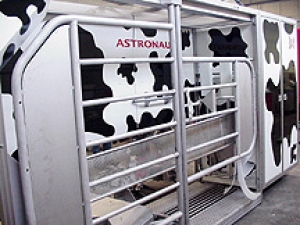Dairy Management
Work starts on world's first commercial robotic milking factory

The automatic milking factory will be built up during the next two to three years and will robotically milk 500-600 cows in a 'voluntary cow traffic system'.

Milk industry farmer Chris Dornauf, who is installing the system says: “We want to manage our farm in a way that allows us to focus on the cows’ performance rather than on the manual task of milking them.”
DeLaval plans further commercial developments in Sweden and in Australia this year, and to expand to other selected markets in 2012.
Despite the recent defeat of the plan for a 'super-dairy' in Nocton, Lincolnshire, many countries including the UK have been moving towards larger scale and zero-grazing units of the type seen in US states like California for some years. Milk factories there are so vast they spread over thousands of acres in enormous open air sheds, surrounded by mountains of feed and million-gallon pools of slurry. In the UK, around 60 per cent of the milk consumed now comes from farms with 150 or more cows and it's changing fast. 8,000 cow units today could well be 16,000 cow units in 10 years time. 'Everybody is now trying to cut costs and unless you can control costs and go big by scaling up with cows you won't last' says milk industry farmer David Handley.
Industry analysts Dairy Co. say the pressure to keep yields high means farmers face a 'daily dilemma' about whether to maintain and treat, or kill a cow with health problems. Slaughter rates in UK herds are now between 18-35 per cent a year, according to DairyCo, with the proportion of cows killed increasing with herd size and milk yield. Likewise, cow mortality also increases with herd size.

Via Farmers Guardian and The Ecologist
Calves carted off
To produce milk, a cow must be forcibly impregnated every year (like all mammals, a cow’s body only produces milk after she has given birth to her offspring). Her calf is usually removed shortly after birth so that the milk meant for him or her can be drunk by us. Just like us, she has a very strong maternal instinct to nurture and protect her calf and suffers immensely when her calf is taken away from her. Cows suffer grief and she may bellow and search for her calf for days. Male calves, from both organic and intensive farms, are either briefly raised for 'veal', or else shot at birth. Up to half a million calves are shot at birth every year in the UK.























